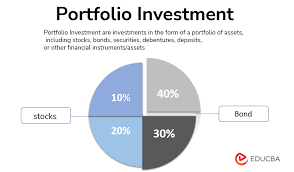An investment portfolio is basically a collection of investments that you hold to achieve your financial goals. It is like a toolbox with different tools for different tasks. The right mix of investments in your portfolio will depend on your individual circumstances and goals.
Here is a breakdown of some key aspects of investment portfolios:
Asset Three Killed:
-
This refers to how you allocate your investment capital across different asset classes. Examples of asset classes include stocks, bonds, cash equivalents, real estate investment trusts (REITs) and commodities.
-
In general, a young investor with a longer time horizon can tolerate more risk and allocate more money to stocks, which have higher growth potential but also carry more risk. . An older investor nearing retirement may prefer capital preservation and allocate more money to bonds, which offer lower risk and returns.

Diversity:
- Don’t put all your eggs in one basket! Spreading your investments across different asset classes and even across classes helps reduce risk. For example, within stocks, you can diversify by company size, sector, and geographic location.
Portfolio Rebalancing:
- Over time, the value of your investments will fluctuate, causing the asset allocation in your portfolio to deviate from your target. Periodic rebalancing involves buying or selling assets to bring your portfolio back to your target allocation.

Types of Investment Portfolios:
- Growth Portfolio: Prefers capital appreciation for long-term goals, especially with a high allocation to stocks.
- Income Portfolio: Focuses on generating regular income through investments such as dividend-paying stocks and bonds.
- Balanced portfolio: Aim for a balance between growth and income, with a mix of stocks and bonds.
- Conservative Portfolio: Prefers capital preservation with a focus on low-risk investments such as bonds and cash equivalents.
Here are some additional factors to consider when building your investment portfolio:
- Risk Tolerance: How much risk are you comfortable with? This will affect your asset allocation.
- Investment time horizon: When will you need investment money? Long-term goals can bear more risk than short-term goals.
- Financial Goals: What are you saving or investing in? Retirement, a down payment on a home, or education expenses will all have different needs.
Remember, not all investment portfolios are the same size. The ideal investment mix will vary depending on your unique circumstances. Consider consulting a financial advisor for personalized guidance on building a portfolio that fits your goals.

Related




